
BEEN quite awhile since I devoted a page to 4th Avenue in Brooklyn; many years ago, I walked it in Park Slope. That stretch of 4th has changed considerably in 19 years, so my post can be considered something of a time capsule. When I lived in Brooklyn for 35 years until 1993, when I bicycled in places like downtown Brooklyn, Cobble Hill, Red Hook, DUMBO, I would use 4th Avenue as a quick way to get home to Bay Ridge. On a bicycle, I have to pay attention to what the cars are doing and I can’t notice architectural detail. Turns out that in Sunset Park, 4th Avenue is pretty lively as far as detail is concerned, and skulking with a camera is the best way to see them. On this walk, I also traveled 5th Avenue, and those results will go on a separate page.

I began at the 53rd Street subway stop and walked a bit south, then a bit north (so, some of the items on the page are seemingly out of exact order). From 2016-2017, a number of stations on the 4th Avenue BMT were given station makeovers, with entrances that look like nothing else in the system, even the new entrances on the 2nd Avenue extension opened in January of 2017. Previously these stations were made over in 1970 with walls of concrete blocks and station signage on unicolored walls of burnt orange, blue, yellow and gray. In 2017, the MTA dispensed with the 1970 colored tile bands and installed much smaller tiles in navy blue throughout the station; it has also painted the pillars on the platforms the same color. New electronic maps and schedules were also added, as well as wifi charging.
Renovated elevated stations in the past two decades have included commissioned artwork in glass panels. That couldn’t be done here, obviously, but a new mural, Title Unknown, by local artist Mickalene Thomas, has been affixed to the blocks.
At the NE corner of 4th Avenue and 54th Street is Light of the World Church, formerly Evangelical Lutheran Church of the Incarnation, built in 1928.
This church, with its impressive pediment and pair of Ionic columns at the NW corner of 4th and 54th Street stumps me as well. Presently the Community Church of Park Slope, I have photos of it from the 1940s and 1980s with the word “Salem” on the pediment.
Update: historian Joe Ditta found this listing. I didn’t google hard enough! It was originally Salem Gospel Tabernacle.
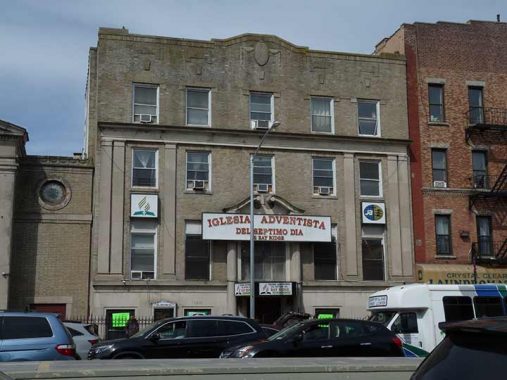
Right next door is this 7th Day Adventist church. The photo from 1940sNYC tabs it as a “Department of Welfare” Office but I suspect it has also had other purposes.
The midblock St. Jacobi Evangelical Lutheran Church, 5406 4th Avenue, features some intricate stonecarving. I was intrigued by the mix of Chinese and German above the entrance. Though Sunset Park’s Chinese and Asians have since the 1980s been concentrated in the area between 7th and 9th Avenues, there has been some migration west into Sunset Park’s Latino and Puerto Rican stronghold.
I depend on the American Guild of Organists to provide architectural details on many churches:
St. Jacobi Evangelical Lutheran Church was organized in 1889 by German immigrants. On October 13, 1889, the fledgling society held its first service in a storefront at 63 – 39th Street, near the water and the Ferry Terminal. In the early years worship was conducted in the German language. In 1890, the society secured its first permanent church building near 4th Avenue and 46th Street. However, with continued growth from the flood of immigrants second generation births the congreation needed a larger home.
Property on Fourth Avenue between 54th & 55th Streets was purchased in 1908, and plans were made for a new edifice. The cornerstone for the present church was laid on Sunday, May 16, 1909. English language services were added In 1914, due in part to the hostilities in Europe. The English-speaking portion of the congregation grew in number as the original and second generation German-speaking members moved or died through the next several decades.
Following World War II, the demographic in the Sunset Park area changed as many white, middle class residents moved to the suburbs. New residents included Spanish-speaking people, mostly from Puerto Rico. Over the next decades the area became home to immigrants from other countries, primarily Central America and the Hispanic Carribean Islands. St. Jacobi and other neighborhood Lutheran churches tried a Spanish Language Mission outreach; St. Jacobi’s program did not succeed as well as had been hoped.
Another wave of immigrants occurred in the 1990s when the neighborhood became home to natives of Russia, India and the Chinese areas of Hong Kong, the Island of Formosa and mainland China, mostly speaking Cantonese or Mandarin. St. Jacobi undertook a new Mission outreach to the Chinese community and called Pastor Ho Kum Lai who hailed from Hong Kong to lead it.
This building, #404 55th Street, corner of 4th Avenue, has Landmarks Preservation Commission protection and is called the “only freestanding mansion” in Sunset Park. It was designed by R. Thomas Short for Dr. Maurice T. Lewis, president of the Bay Ridge Savings Bank, who resided here from 1907 until his death in 1931. That year, physician Sonya Monen, Lieutenant Commander of the U.S. Coast Guard Women’s Reserve, moved in and practiced medicine here all the way to her own death in 1996. The landmark designation is fortuitous, as a developer purchased the building, intending to raze it to build condos without success; he claims landmarking the building devalued the property.
I got a glimpse of the Emmanuel Pentacostal Temple’s spire looking west on 55th Street from 4th. Here’s a Street View look. I suspect the Mobil service station shown on the 1940 photo just may be the same building, extensively remodeled.
The Bethelship Norwegian United Methodist Church, 4th Avenue and 56th Street, is one of the few reminders that Sunset Park and Bay Ridge were once heavily populated with immigrants from Scandinavia: Norway, Sweden, Finland and Denmark. Bay Ridge boasted a considerable Scandinavian population, primarily Norwegian (Nordisk Tidende was to be found on most newsstands, and a number of Danish bakeries lined Fifth Avenue). The immigrants primarily worked the docks when Brooklyn was a major port. The Scandinavian legacy is being preserved by the annual Norwegian Independence Day Parade in May, Lutheran Medical Center on 2nd Avenue and 54th Street (founded in 1883 by a Norwegian Lutheran nurse, Sister Elizabeth Fedde, which is improbably noted in the signage at the 53rd Street BMT subway station), and a few other locations. The Danish Athletic Club on 65th Street and Gjøa Sporting Club around the block on 64th are also survivors.
The blocks between 40th and 44th Streets from 7th to 9th Avenues (see this FNY page) were home to a substantial Finnish population. Finland is in Scandinavia (with Norway, Sweden and Denmark), but its language is from a different root and is unlike Danish, Swedish or Norwegian. In Finland, the country is called Suomi; the word doesn’t resemble other Scandinavian country names’ English counterparts such as Sverige, Norge and Danmark.
Once again, American Guild of Organists comes through with some details:
The Bethelship Norwegian Methodist Episcopal Church, organized sometime in the mid-1800s, was originally known as the Mariners’ Methodist Episcopal Church. The society’s first known building was erected at the southwest corner of President and Van Brunt Streets, near the docks, on a plot measuring 50 by 100 feet. This edifice, built of brick and trimmed with blue stone, was 65 feet in length and 38 feet wide. On either side of the porch at the President Street end of the church were commodious classrooms, over which was a large apartment to be used for prayer meetings and other similar purposes. The building was a gift of Edwin Mead, a wealthy shipping merchant, in memory of his daughter, Julia. In 1891, the society moved into the former Carroll Park Methodist Episcopal Church at 297-299 Carroll Street near Hoyt Street, and officially changed its name to Bethelship Norwegian M.E. Church.
After six decades in Carroll Gardens, the congregation moved in 1949 to its present location at the corner of 56th Street and Fourth Avenue in Sunset Park.
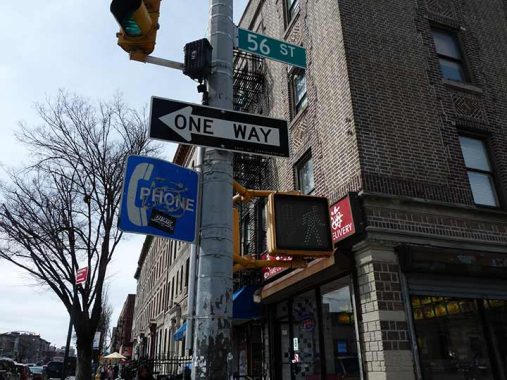
In the absence of a public phone at 4th Avenue and 56th Street this was likely a sign indicating there was a public phone in the establishment on the corner.
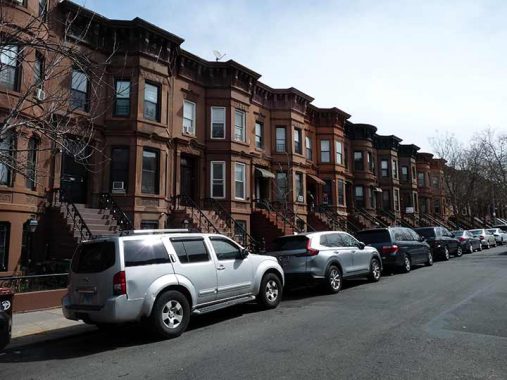
56th Street east of 4th Avenue. I have always admired Sunset Park’s step and repeat attached two-family dwellings. They are even more dramatically highlighted on west-facing streets as they lead down to Upper New York Bay, where so many of their residents worked on waterside docks.
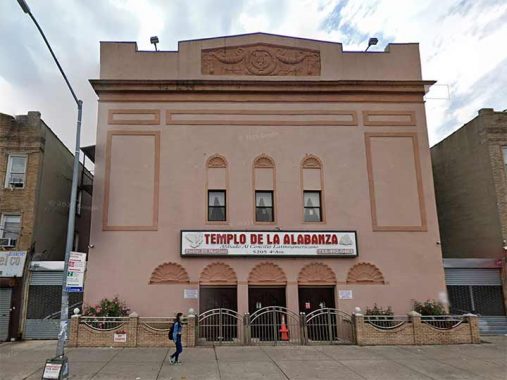
Heading back north on 4th Avenue, here at #5205 is the Templo de la Alabanza, built in 1920 as the Coliseum Theater. 4th Avenue boasts a number of theaters built in the wake of the BMT’s 1916 opening. It continued as a theater all the way to 1992.
It was built as the Coliseum Theater for impresario Henry C. Pulch, and was designed by New York architect Matthew W. Del Gaudio. The two men built three theaters in Brooklyn, the other two being the Dyker Theater in Dyker Heights and the Shore Theater in Bay Ridge. Del Guadio also designed two other theaters in Brooklyn for another producer. Today, the Dyker is a Modell’s and Radio Shack and the Shore is a mini-mall with a Zales, Foot Locker and PayLess spanning the old theater building. [Brownstoner]
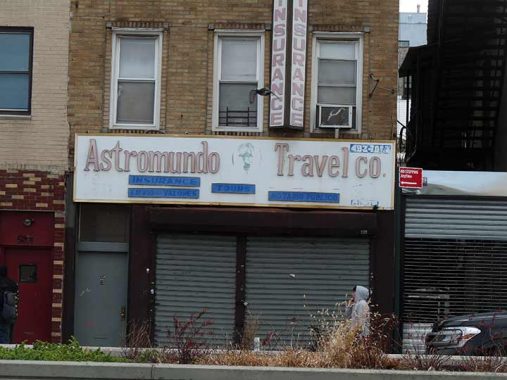
I have begin to feature some sidewalk storefront signs I find interestin. The ones with plastic lettering are all a certain age, likely going back to the 1970s and 1980s. This one is a couple of doors down from the theater/church.
When I passed this 4-story building on 4th Avenue and 51st Street awhile ago, I didn’t know what I had found. There were chiseled signs on the avenue side: “4th Avenue,” “Parkway”, “Garage” and “1907.” However, in a Facebook group called “Everyone Who Loves Brooklyn,” I discovered that this was called Scandia Hall and it hosted meetings and parties catering to the Norwegians in the neighborhood.

Looking at the old photo, its identity as a garage is easier to discern, with two large arched doors. “Parkway” likely referred to the word in its literal sense, a place to park. Automobiles were still rather rare in 1907, so the garage is truly an artifact. The building also hosted a car dealership and furniture store in its later years.
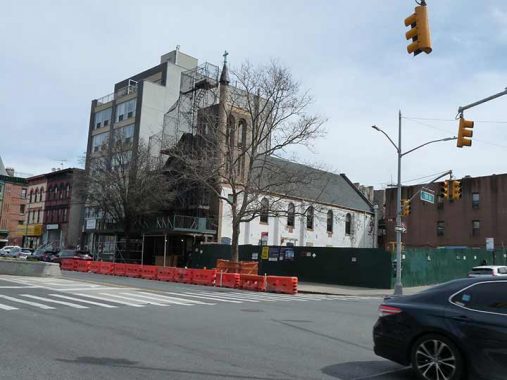
Unfortunately St. Andrew’s Episcopal Church, midblock on 4th Avenue between 49th and 50th Streets, was partially obscured by scaffolding: but I have always been intrigued by skinny towers on churches, police precints etc., so I snapped it anyway.
This Romanesque Revival church is Sunset Park’s oldest church. [Architect Lawrence] Valk was a prolific designer of churches throughout the United States, many in this same Romanesque style. The church is graced with many unusual and charming features, including the arches of varying heights and widths on the front façade and a skinny column running up the side of its bell tower, capped with a small turret and modest cross. [Historic Districts Council]

At some time in the 1980s, 49th Street in Sunset Park, as far east as 8th Avenue, has been subnamed “Sunset Terrace” on street signs. Since then, I’ve been stumped by the designation.
I find the 4th Avenue United Methodist Church at 47th Street the most interesting architecturally of all of 4th Avenue’s Sunset Park church buildings, with its slanted “chamfered” side on the cron er, stained glass and large arched windows. Unfortunately it’s poorly documented online. It is a primarily Asian congregation today.
Once again I’ll turn to the American Guild of Organists, this time for information on Trinity Lutheran Church, 4th Avenue at 46th Street:
Trinity Lutheran Church had it roots in the religious revival which swept over Southern Norway in the latter part of the 19th century. Norwegian immigrants, who had been profoundly influenced by this spiritual awakening, settled in Brooklyn and met informally for fellowship and Christian nurture. The need for the formation of a congregation was apparent, and Trinity Norwegian Lutheran Church in Brooklyn’s Sunset Park/Bay Ridge area was organized on July 29, 1890. During the following year the society became part of the United Norgwegian Lutheran Church in America. The first church building was located on the corner of 22nd Street and Third Avenue. Services were conducted in the Norwegian language until 1915, when English worship and instruction were added.
The present building on the corner of 46th Street and Fourth Avenue was constructed between 1910 and 1917. Built of brick with limestone trim, the church and adjoining two-story rectory were designed in the Neo-Gothic style by Foster, Gade & Graham. The Sigmond Memorial Education building was added in 1950. The church and rectory are listed in the National Registry of Historic Places in the Sunset Park Historic District.
At 45th Street is a sample of mid-century subway entrance construction. This isn’t the original entrance from 1916; in fact, many of the original BMT subway entrances on 4th Avenue were in the center traffic median, when the avenue wasn’t quite as pedal to the metal as it is today. Now, only one original BMT 4th Avenue entrance is still in existence, at 77th Street.
68th Precinct
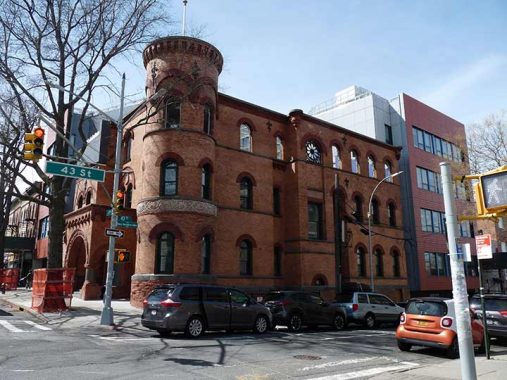
The best time to get photos of the newly restored 68th Precinct stationhouse on 4th Avenue and 42nd is during the winter, as there’s a tree blocking the view in front of it. Notice the newly revealed details, like the stonework of guard dogs. after over 50 years during which it sad idle as a deteriorating hulk, the old stationhouse will become a grade school. The renovation was done at the cost of its stables on 4th Avenue, which were demolished to make way for residences.
The building was an early addition to the Sunset Park scene. The Romanesque revival buildings designed by Emile M. Gruwe as the 18th Precinct (now attributed to George Ingram, per this 1890 newspaper listing) were completed in 1886, even predating Sunset Park itself and the Bush Terminal buildings along the waterfront, which began to appear in 1890. After Brooklyn was annexed to NYC in 1898 this building became an NYPD precinct and went from the 18th to 43rd to 143rd to finally the 68th Precinct. Gruwe also designed the nearly identical 75th Precinct building, also in disrepair, on Liberty and Miller Avenues in East New York — itself newly restored.
The building had been mostly vacant since the 68th merged with another precinct in Bay Ridge in 1971 and moved into a new building further north on 4th Avenue and 29th Street.
Sunset Park’s architectural riches are also manifested across 4th Avenue from the 68th Precinct and St. Michael’s Church (see below) at 4201, where stands the former Sunset Park Court House or Magistrates’ Court, a relatively recent addition from 1931 (Mortimer D. Metcalfe, arch.). It was one of four ‘regional’ courthouses that handled local cases before courts were centralized on Brooklyn’s Legal Row on Cadman Plaza West in 1962. Defendants processed in the 68th Precinct across the street were arraigned here. Grand Ionic-columned entrances appear on both the 42nd and 43rd Street sides.
After the court moved out in 1962 the building was used for decades as offices by Community Board 7 and later as a police training venue. After several years of disrepair, it was renovated in 1996. Montrose Morris has more in Brownstoner. In 2020, it was the temporary Sunset Park Brooklyn Public Library branch.
St. Michael’s
The incredibly tall, 200-foot high campanile of St. Michael’s Church, a parish founded in 1870, dominates 4th Avenue’s central corridor. The current church, designed by Raymond Almirall, was dedicated in 1905. That year, it was the tallest building in Brooklyn and was later succeeded by the Williamsburg Bank tower now called One Hanson in 1928 (which itself has been succeeded a couple of times since). Almirall designed a similar, but much shorter, structure in Queens’ Calvary Cemetery in 1895, the cemetery chapel. With their “beehive” towers, both buildings resembles the Cathedral of the Sacred Heart in Paris. The Calvary chapel also served as a burial crypt for NYC’s parish priests.
Though the adjacent St. Michael’s parish school was closed in 2005, the building still hosts PS 522. The chiseled in identifier still appears on the facade, along with an incredible “AE” ligature. The combo “ae” doesn’t appear much in English, mostly in Latin loanwords, but it’s survived over the centuries in the given names Michael and Raphael, both Archangels in the Christian canon. Rarer still is the printed ligature for capital AE; you see if often in the lowercase combo. I’ve only ever seen it in print for the Latin name AEgyptus.

One last bit of superiority on 4th Avenue’s Architecture Row is the Charles O. Dewey IS 136, originally PS 136, at #4004 4th. I do not know the architect or date of construction but could be C.B.J. Snyder in the early 20th Century.
There’s something a bit different about the standard issue octagonal-shaft lamppossts on this stretch. The lamp masts are detachable, and are mounted further down on the pole than usual. The cap, or finial, is the same bullet-shaped ones employed on Flatbush Avenue, 8th Avenue in Hells Kitchen, and other locales.
A couple of samples of residential housing on the should-be-landmarked section of Sunset Park, 40th Street between 4th and 5th Avenues.
Check out the ForgottenBook, take a look at the gift shop. As always, “comment…as you see fit.” I earn a small payment when you click on any ad on the site.
6/1/25

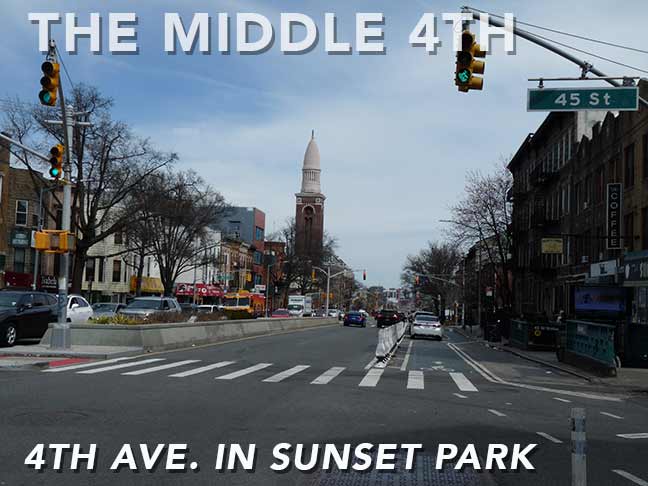
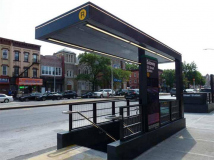
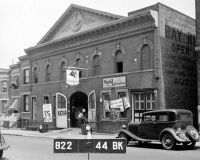
5 comments
Stanley Kubrick shot a movie in Sunset Park called”The Seafarers”
I read something about those “phone” signs that was pretty funny. A punk band in the 70s had a loft on 17th Street in Chelsea and got money for installing a public phone in their loft, and the sign was put outside. They did it for the money and to use it for themselves. From the interview on the Rialto Report:
“We got a pay phone installed there because you could get one in your loft if it was a commercial business. You just had to put a sign up saying you had a pay phone there. This meant you could get incoming calls – which was important for getting gigs. We figured shit like that out right away.
But what happened if someone came to your place and actually asked to use your phone?!
Every so often somebody would see the sign, and come to the door, and say, “Hey, I need to use the phone.”
We’d just say “Fuck that sign. Don’t believe everything you see. Get the fuck out of here.””
https://www.therialtoreport.com/2019/09/22/tim-connelly/
Finnish is similar to Estonian, and *very* distantly related to Hungarian, but that’s about it. In fact it’s not even in the Indo-European language family.
When Sunset Park was more heavily Scandinavian you probably could get Lutefisk in grocery stores, but I highly doubt that’s still possible.
Isolated tongue, like Basque
I could be wrong, but 4th Ave, before the subways, was originally called 4th Ave Parkway. The hall was built in 1907. I believe the “Parkway” on the building referred to the street it was on. Thanks for siting ny page!